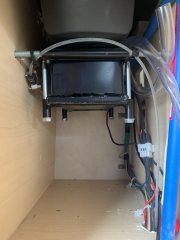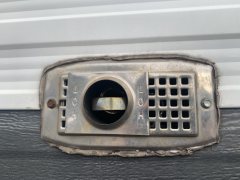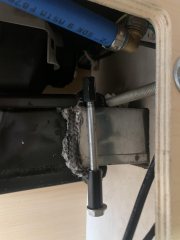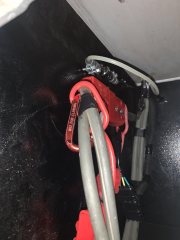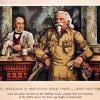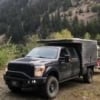Something a little different...
We've been playing with a portable diesel heater in our Transit van. We used it on a five-week trip to Texas last winter and a four-week trip to Quebec in October. While I'm very glad to have it, there are tradeoffs (more on that below).
It's basically a Planar diesel parking heater mounted in a high-quality Kanuk hard case. I power it via my house battery, a 100 ah AGM in the rear corner of the van. It comes with a 21-ft power cable I attached to my battery via ring-eye connectors. I keep that cable coiled up by the battery. When I first tried it, I realized I could simply run the power cable out between the two rear doors. (At the very bottom where the doors meet, there's a small section of door seal which can be lifted away enough for the cable to pass). The cable length allows me to place the heater outside of (and just aft of) the van's driver-side door.
I made a plywood insert for my driver-door window for the air duct and the control cable to pass back into the van. I've found it best to install the insert, close the door and then run the duct and cable. (I first tried running the duct and cable before closing the window on the insert and quickly realized I don't have enough hands to keep everything in place and close the window and then the door). I use a 10-foot length of duct pipe and simply run it across the driver seat and then down to the floor, ending in the aisle just behind the seats. I can use the seat's arm rest to raise the duct pipe a foot or two off the floor if I prefer.
The heater is diesel and the van is gas but I don't consider that an issue. That may be important to a full-time van-lifer but I get about four camping days out of the little tank on the side of the heater and I only fill it about 3/4 full. (I had initially been concerned about diesel possibly spilling out of the cap-vent but then realized that a 3/4 fill is plenty for the way I use it... and lighter to carry.)
I went with the portable as I wasn't ready to commit to cutting into the van and didn't like the placement options I was seeing. Rather than wait to figure that out I could start with the portable to see if I even liked it. And if I liked it but wanted a permanent installation, I could either sell it to finance a cheaper kit version or simply take it out of the case and install it in the van.
I should also note that this is a relatively expensive heater (about $1375 plus tax and shipping). While you can get a Chinese diesel heater kit for under $200, the Planar heater kit alone is in the $850 range. I saw several YouTube guys were putting Chinese ones in cases for their roof-top-tent rigs and considered that. But I was also seeing some of those same guys then building version 2 or following up with a 'mistakes I made' video. I figured I could either save money but possibly waste time and have to mess around getting a portable right or I could spend the money and go camping now. Once I added up the cost of a Planar kit, the case, the heater and fuel pump mounts, thru-case fittings, exhaust mount, insulation and shield, etc, I decided I'd rather buy the already-assembled portable.
I was also drawn to the fact that the portable Planar is self-adjusting up to 8200-ft altitude. And the fuel pump is the quieter model. And I liked seeing that replacement parts specifically for the portable are available on the web site. And there are installation, operation, and repair manuals for my model. I've talked with the distributor several times and have gotten reasonably good answers to my questions.
This portable version of these heaters was designed and assembled by Planar Distribution, Ltd, the North American distributor for Planar products. They're in Surrey, British Columbia. I ordered mine online via the Main Line Overland web site. Support info is on the distributor's web site: planarheaters.com (Note that prices there are in Canadian dollars and on the Main Line site in US dollars)
There are two versions of these portables, the 2D (about 7000 btu/hr) and the 44D (about 13,600 btu/hr). I have the 2D. My heater was back-ordered but the distributor gave me an estimate of when my order could be filled and that turned out to be accurate. I had about a 30-day wait from order to shipping.
Main Line Overland listing
NorthShoreHenry video on the 2d and 44d
Ok, so on to using it....
1- I'm surprised how loud the exhaust is. It's similar to a generator. I wouldn't want to be parked next to me in a campground. Last winter I walked around outside my van with the heater running and assessed it like this: I was in a campground with typically-close state park campsites. As I listened from different directions I realized the sound probably wouldn't bother me if I were camped in the site on the passenger side of my van (with the van between me and the sound). But if I were in the site on my van's driver side, I'd be bothered, particularly if I were in a tent or pop-up or sitting around the campfire. Two campsites away was better but I felt I had to be at least 100 feet away before the sound was reasonable. This isn't typically a problem as I seek out campsites away from people but that's not always possible. I'll probably try putting a muffler on it but need to find something that works well with this portable form factor, i.e. doesn't get in the way for storage and is stable in use.
2- Oddly enough the exhaust noise isn't a problem inside the van. I can tell it's running there outside the van but the loudest sound inside is the slightly-metallic-sounding rush of air coming out of the duct pipe (running on high). I only hear the ticking of the pump if I listen very closely. We turn the heater off before going to bed so perhaps the outside sound would be more of a problem if we didn't do that.
3 - In a more-perfect world I'd have a good out-of-the-way space to store the portable. I'm currently shifting it about as needed through the day as we travel. It's too tall for my under-bed storage in back so I keep it in the walkway. When we stop for lunch, I set it outside or shift it around. When we stop for the night and we're not going to use it, I store it up front in the driver-side footwell (under the steering wheel).
4 - It's slow to start up and shut down. After getting everything assembled and checking that the dial is turned up to high, I push a button once to start it. It briefly spins up the fan but then nothing seems to happen for a long time (about a minute). I now know that the glow plug is being heated up in that interval. I go out beside the heater and eventually hear a clunk-- the first pulse of the fuel pump. Then another clunk and a bit of a whoosh sound as it tries ignition in the combustion chamber and seems to pulse the fan. Then I see a puff of white smoke and I notice a brief smell of diesel fuel from the exhaust pipe. Then I hear the flame flare in the combustion chamber and the fan slowly ramps up to full speed. Current draw during glow-plug heating and initial fire-up is between 9 and 10 amps and remains high for about two and a half minutes. Then it drops to around 1 amp. At bedtime I push the button again to shut it down. It takes a long time to wind down as the fan keeps running to clear the combustion chamber for a few minutes.
5. The next morning we don't bother with the diesel heater as we're typically moving on. We use our tried-and-true Buddy heater as it warms the space up faster and it doesn't blow ice-cold air at you during startup. We also use the Buddy to warm our clothes before putting them on (that's wonderful) and we use it to heat water for morning wash-up. Oh, yeah, I should also mention that we plug up the Planar's duct pipe before going to bed. If there's any wind at all outside, we get a surprisingly-strong flow of cold air coming out of the duct.
6. I chose the 2K heater and sometimes wonder if I should have gone with the 4K one. The first time I used it was a 25*F day dropping to 18*F that evening. I had my temp gun along and saw that I couldn't get the back door area of the van's interior above 60*F and about 65*F in the main area. I eventually thought to fire up the Buddy heater and that quickly fixed that. I still have some insulation work to do in the van and plan to add an insulated cover to the outside vent-pipe so that may not be necessary in the future.






